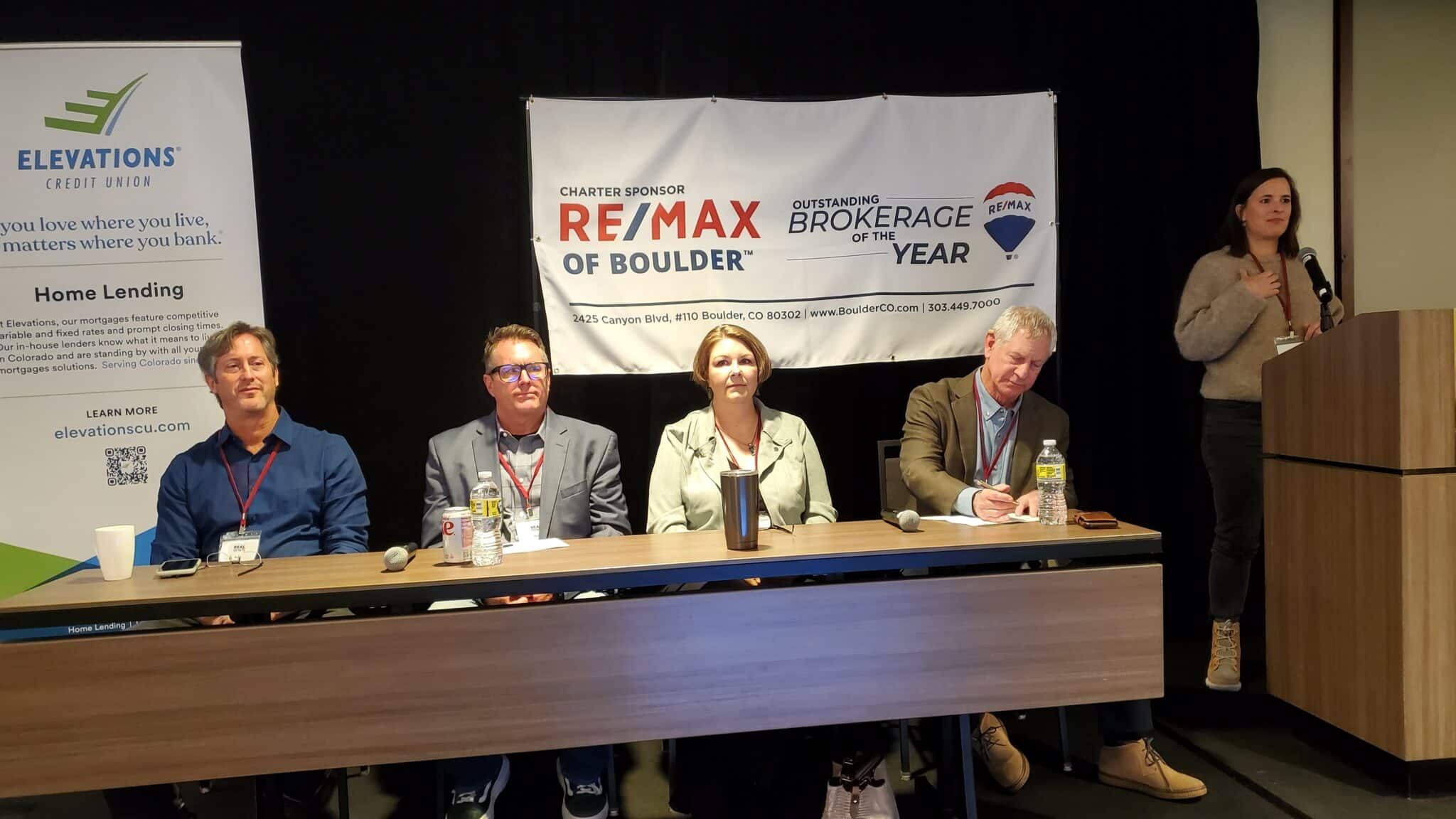RE Conference: Panel cites Marshall Fire’s challenges, ‘deferred dreams’

BOULDER – Boulder County is still reeling from the impacts of the Marshall Fire and will be for years to come, panelists at BizWest’s Boulder Valley Real Estate Conference agreed Thursday.
Propelled by hurricane-force winds that followed an unseasonably dry and warm spell, the Dec. 30, 2021 fire, the most destructive in Colorado history in terms of property lost, claimed two lives and an estimated 1,084 structures, including houses, a hotel and at least one shopping center in Louisville, Superior and surrounding unincorporated areas of Boulder County.
“It just wasn’t going to be stopped,” said Kristin Taylor, operations manager for Blue Spruce Construction Services.”
SPONSORED CONTENT
The fire’s aftermath left affected homeowners scrambling to figure out how or whether they could rebuild, and how and where they could live in the meantime.
“The first catastrophe happened when the fire occurred and people lost their homes,” said Scott Rodwin, president of Rodwin Architecture and Skycastle Construction. “The second catastrophe is probably about to happen, starting now.
“The first wave of people who decided to rebuild are right now starting to get into the final conversations with insurance companies about what they’ll cover,” he said, “and simultaneously they’re working with an architect or builder and receiving their first real bid on what it’s going to cost to rebuild their house. Those two numbers, I can guarantee you, are not going to be close to each other.
“Folks have been holding out strong hope that they’re going to be able to rebuild. Some will. Many will have to make adjustments – smaller size, fewer features, reductions, and some deferred dreams.”
Said Taylor: “The idea that people are going to rebuild what they had is not what we’re seeing. It’s just not going to be their house.”
Rodwin said the gap will mean there will be “a very large group of people for whom the gulf is too big, and they’ll have to make decisions – do I simply give up at this point? There’s a really harsh reality attached to it. Many will not be able to close the gap, or they’ll get timed out because the process is simply taking too long.”
Fueling the catastrophe, he said, are the delays in rebuilding and the spiraling costs.
“Those are the two main issues we generally see: Money and time,” Rodwin said. “People say, ‘How long will it take to get back in my house?’ and we have to tell them three years.”
The time to replace a house used to be two years, he said, but the COVID-19 pandemic expanded the wait to 2 1/2 years because of supply-chain and workforce issues, and the Marshall Fire stretched it to three because of the “finite resources we have for construction.”
Rodwin said he’s currently doing five rebuilds but has had to turn down 45.
“There’s two different timetables, one for custom homes and one for production homes,” said Josh Marks, equity partner at law firm Berg Hill Greenleaf Ruscitti LLP. “Certain production home builders have a little more capacity and have jumped into the custom-home rebuild process, but it took them quite a few months to pivot.”
Taylor echoed the general exasperation. “The process takes so much energy,” she said. “We are re-estimating, re-estimating, re-estimating – and trying to help everyone understand.”
Building costs were rising 10% a year since 2012, Rodwin said, but spiraled to 30% or 40% during the pandemic.
“These are astronomical numbers,” Rodwin said, adding that as homebuilders, “We can’t keep up with it and we can’t predict it. We’d always been able to predict it; now we have no idea.”
With the increase in real estate prices has come the increased cost of construction, Rodwin said, and “insurance companies have not, by and large, gotten the message. The insurance company is willing to give $1 million and the builder says the house is going to cost $2 million
The difference between what the insurance companies are willing to pay and the actual cost of rebuilding is astronomical. It’s not just 5%; it can be 100% different. And most people don’t know what their budget is until they see what insurance will cover.”
For instance, he said, “building codes and client expectations have reshaped what we are building these days. Today’s geotechnical engineers will require you to put in caissons 38 feet down – and that might add $130,000 to the cost of a typical house.”
Panel moderator Alicia Miller, a broker/associate with Re/Max of Boulder, noted that “I don’t know if everybody realizes the fact that people do not necessarily have to rebuild on the same lot. For some people that means going farther east.” And for others, she added, it could mean finding an existing house to remodel instead of rebuilding at all.
But for those displaced homeowners who choose to endure the wait to rebuild, how and where would they live in the meantime?
“Unlike almost any other client we have that already has a house and can live there until they move into their new one,” Rodwin said, “these people don’t have a house.”
Their fate, noted Marks, is often “insurance-company dependent. Some folks will be left without additional living-expense coverage. Once it’s up, the companies don’t have an obligation to extend that.”
Marks also cited “an incredible backlog on the ability to do soils testing,” a vital consideration because of the often toxic compounds released into the ground as well as into smoke-damaged housing.
Usually after a fire, if nearby homes were simply shrouded in smoke, fumes from the ash could be mitigated through cleaning, painting, repairs and replacing carpet, said Brett Allen, external-relations chair for the Rocky Mountain Association of Public Insurance Adjusters. But because of the “nuances of the Marshall Fire,” he said, the levels of toxicity have been “extremely scary” and the “scope of work to get them back to pre-loss condition is up 20-fold. With such long-term exposure, there’s really a danger.”
Clearing the debris poses hazards as well, Allen said, even for houses that didn’t burn.
“Houses have been bulldozed, and for existing houses nearby it kicks up those contaminants,” he said. “Some people got back in quickly and had their houses cleaned, but then they’re recontaminated. The process has to happen again and again.”
Rodwin noted that homeowners in the affected areas often ask whether there was anything they could have done to save their houses. “With 100-mile-per-hour winds and the fire’s intense heat, there really was nothing. Most houses that burned down burned down from inside; burning debris from neighbor’s houses fly through the air at 100 miles an hour and smash through windows or get sucked through soffit vents and into attics.”
Marks, who lost his own home in Coal Creek Ranch, predicted many lots will remain vacant in his subdivision for years, noting that so far, nearly 11 months after the fire, there still have only been 10 to 14 rebuilds started out of 140 lots in his neighborhood.
The upside to that, however, Taylor said, is that “we have not had lots available in years in Boulder County, and there are people from outside who want to get in. This is a place where people want to be.”
Rodwin said homeowners who choose to rebuild can save money by taking advantage of rebates for energy-saving measures. “The typical homeowner can easily achieve $25,000 to $35,000 savings in energy-efficiency rebates just by doing nothing more than having things more energy-efficient.”
For those affected homeowners who want to stay, Rodwin said, “the community has done an astonishing job in rallying to help Marshall Fire victims,” and “municipalities have dramatically streamlined the permitting process.”
Colorado, said Marks, “has the most favorable consumer-protection laws in the nation.
“There will be pressure put on for insurance companies to step up and do the right thing,” he said. “We do live in a great state where people care about each other.”
BOULDER – Boulder County is still reeling from the impacts of the Marshall Fire and will be for years to come, panelists at BizWest’s Boulder Valley Real Estate Conference agreed Thursday.
Propelled by hurricane-force winds that followed an unseasonably dry and warm spell, the Dec. 30, 2021 fire, the most destructive in Colorado history in terms of property lost, claimed two lives and an estimated 1,084 structures, including houses, a hotel and at least one shopping center in Louisville, Superior and surrounding unincorporated areas of Boulder County.
“It just wasn’t going to be stopped,” said Kristin Taylor, operations manager for Blue Spruce…
THIS ARTICLE IS FOR SUBSCRIBERS ONLY
Continue reading for less than $3 per week!
Get a month of award-winning local business news, trends and insights
Access award-winning content today!



